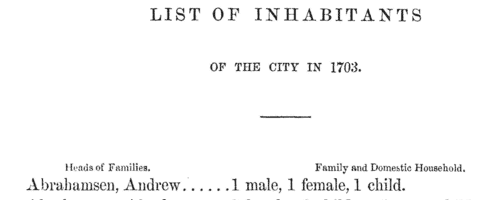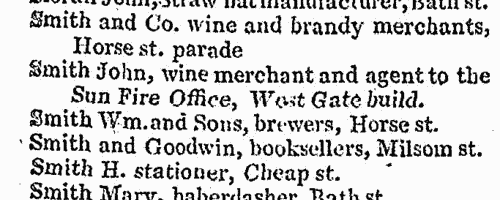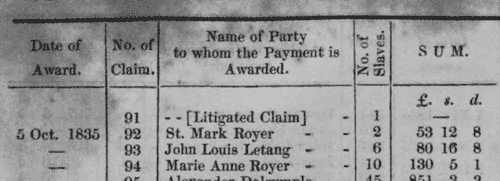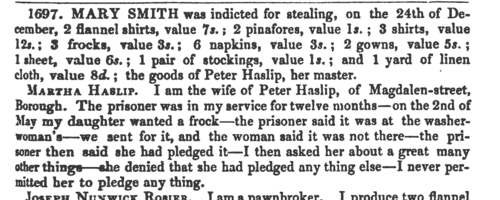Myler Surname Ancestry ResultsOur indexes 1000-1999 include entries for the spelling 'myler'. In the period you have requested, we have the following 19 records (displaying 1 to 10): Single Surname Subscription | | | Buying all 19 results of this search individually would cost £104.00. But you can have free access to all 19 records for a year, to view, to save and print, for £100. Save £4.00. More... |
These sample scans are from the original record. You will get scans of the full pages or articles where the surname you searched for has been found. Your web browser may prevent the sample windows from opening; in this case please change your browser settings to allow pop-up windows from this site. Secretary of State's Papers
(1600)
The letters and papers of sir Robert Cecil, Secretary of State, deal with all manner of government business in England, Ireland and abroad.MYLER. Cost: £4.00.  | Sample scan, click to enlarge

| Heads of Families in New York
(1703)
This census of households in New York gives the name of each head of family in full, surname first, and then the number of males, females, children, negroes, negresses and negro children in each family and domestic household.MYLER. Cost: £6.00.  | Sample scan, click to enlarge

| Masters of Merchantmen
(1804)
The Society for the Registry of Shipping was instituted in 1760, and published an annual register and supplement. The annual register consisted of an alphabetical list of ships surveyed for insurance in Britain and Ireland, together with an alphabetical supplement. The society maintained a Registry Office at which alterations and additions were notified, and members delivering their registers when called for had them updated and returned on the following or the ensuing day. Each ship was given a number within each letter of the alphabet: ships' names were not unique, so within each name a ship was identified by the name of the captain or master at the time of the last survey. Then abbreviations indicate the type of vessel (Bg, brig; Cr, cutter; Dr, dogger; G, galliott; H, hoy; K, ketch; S, ship; Sk, smack; Sp, sloop; Sr, schooner; St, schoot; Sw, snow), and whether sheathed (s) and/or doubled (d) with copper (C) and iron bolts (I B) or over boards (W & C), or copper fastened (c f) or copper bolted (c b), sometimes with a date, such as (17)88. The third column, reserved for masters' names, is not particularly wide; with short surnames, an initial will be given; but longer surnames omit the initials, and even longer surnames are abbreviated. It will be borne in mind that these are the names of the masters not (necessarily) in 1804, but at the time of the last survey. Often new masters had been appointed by the time of re-survey, and their names are added in slightly smaller type under the original master's names in the third column. In the fourth column is the tonnage: where there is a blank under the number this indicates that the ship had two decks; more often the letters S D (B) for single deck (with beams); D W for deep waist; S D W single deck with deep waist; B D W single deck with beams and deep waist. Underneath the entry may run references to recent repairs: Cl. clincher built; Drp. damages repaired; grp. good repairs; len. lengthened; lrp. large repairs; N. (new) B. bottom, D. deck, Kl. keel, Sds. sides or UW. upper-works; rb. rebuilt; rsd. raised; S. rprs. some repairs; or trp. thorough Repair. In italics, the timber of the ship is described - B. B., black birch; C., cedar; H., hazel; J., juniper; L. O., live oak; M., mahogany; P., pine; P. P., pitch pine; S., spruce; W. H., witch hazel. Where the vessel was armed, the number of guns is given, and occasionally a remark such as 'captured' will appear. The fifth column gives the place that the ship was built. For foreign ships this may be as vague as 'Dutch' or 'French'; but nothing in this record specifically indicates the nationality of ship, master or owners, except that an A. under the owner's name indicates that the vessel was United States property. The sixth column gives the year of the ship's age; some were still sailing after 30 or 40 years. The seventh column gives the owner's name, abbreviated in the same way as the master's name. Where the master was the owner, the word Capt. will appear. With vessels owned abroad, the name in this column is sometimes that of the port of origin, not the surname of the owner. Where there has been a change of owner by the time of re-survey, the new name is put underneath in smaller type. The printer sought to avoid confusion by aligning names of ports to the left and surnames to the right, but that leaves longer names doubtful. The eighth column gives the feet of the draught of water when loaded. The ninth column shows the destined voyage for which the survey took place, with the port of survey abbreviated (Be., Belfast; Br., Bristol; Co., Cork; Cs, Cowes; Da., Dartmouth; Du., Dublin; Eh, Exmouth; Ex., Exeter; Fa., Falmouth; Gr., Greenock; Hl, Hull; La., Lancaster; Lh, Leith; Li., Liverpool; Lo., London; Ly., Lynn; Po., Poole; Ph, Portsmouth; Sc., Star-Cross; Tn., Teignmouth; Tp., Topsham; Wa., Waterford; Wn, Whitehaven; Ya., Yarmouth), and the letter C where the vessel was a constant trader between the two ports. The tenth column gives the classification of the vessel (A, first; E, second; I., third - O and U for fourth and fifth are never used) and its stores (1, first; 2, second; 3, third) and the year of survey, e. g. 00 for 1800, or, if surveyed during 1803, the month, e. g. 3 for March. Where the vessel has been re-surveyed, the classification letter and number will be repeated or revised in the final column. The sample scan is from the main list. This is the index to masters in the main list.MYLER. Cost: £6.00.  | Sample scan, click to enlarge

| Owners of Merchantmen
(1804)
The Society for the Registry of Shipping was instituted in 1760, and published an annual register and supplement. The annual register consisted of an alphabetical list of ships surveyed for insurance in Britain and Ireland, together with an alphabetical supplement. The society maintained a Registry Office at which alterations and additions were notified, and members delivering their registers when called for had them updated and returned on the following or the ensuing day. Each ship was given a number within each letter of the alphabet: ships' names were not unique, so within each name a ship was identified by the name of the captain or master at the time of the last survey. Then abbreviations indicate the type of vessel (Bg, brig; Cr, cutter; Dr, dogger; G, galliott; H, hoy; K, ketch; S, ship; Sk, smack; Sp, sloop; Sr, schooner; St, schoot; Sw, snow), and whether sheathed (s) and/or doubled (d) with copper (C) and iron bolts (I B) or over boards (W & C), or copper fastened (c f) or copper bolted (c b), sometimes with a date, such as (17)88. The third column, reserved for masters' names, is not particularly wide; with short surnames, an initial will be given; but longer surnames omit the initials, and even longer surnames are abbreviated. It will be borne in mind that these are the names of the masters not (necessarily) in 1804, but at the time of the last survey. Often new masters had been appointed by the time of re-survey, and their names are added in slightly smaller type under the original master's names in the third column. In the fourth column is the tonnage: where there is a blank under the number this indicates that the ship had two decks; more often the letters S D (B) for single deck (with beams); D W for deep waist; S D W single deck with deep waist; B D W single deck with beams and deep waist. Underneath the entry may run references to recent repairs: Cl. clincher built; Drp. damages repaired; grp. good repairs; len. lengthened; lrp. large repairs; N. (new) B. bottom, D. deck, Kl. keel, Sds. sides or UW. upper-works; rb. rebuilt; rsd. raised; S. rprs. some repairs; or trp. thorough Repair. In italics, the timber of the ship is described - B. B., black birch; C., cedar; H., hazel; J., juniper; L. O., live oak; M., mahogany; P., pine; P. P., pitch pine; S., spruce; W. H., witch hazel. Where the vessel was armed, the number of guns is given, and occasionally a remark such as 'captured' will appear. The fifth column gives the place that the ship was built. For foreign ships this may be as vague as 'Dutch' or 'French'; but nothing in this record specifically indicates the nationality of ship, master or owners, except that an A. under the owner's name indicates that the vessel was United States property. The sixth column gives the year of the ship's age; some were still sailing after 30 or 40 years. The seventh column gives the owner's name, abbreviated in the same way as the master's name. Where the master was the owner, the word Capt. will appear. With vessels owned abroad, the name in this column is sometimes that of the port of origin, not the surname of the owner. Where there has been a change of owner by the time of re-survey, the new name is put underneath in smaller type. The printer sought to avoid confusion by aligning names of ports to the left and surnames to the right, but that leaves longer names doubtful. The eighth column gives the feet of the draught of water when loaded. The ninth column shows the destined voyage for which the survey took place, with the port of survey abbreviated (Be., Belfast; Br., Bristol; Co., Cork; Cs, Cowes; Da., Dartmouth; Du., Dublin; Eh, Exmouth; Ex., Exeter; Fa., Falmouth; Gr., Greenock; Hl, Hull; La., Lancaster; Lh, Leith; Li., Liverpool; Lo., London; Ly., Lynn; Po., Poole; Ph, Portsmouth; Sc., Star-Cross; Tn., Teignmouth; Tp., Topsham; Wa., Waterford; Wn, Whitehaven; Ya., Yarmouth), and the letter C where the vessel was a constant trader between the two ports. The tenth column gives the classification of the vessel (A, first; E, second; I., third - O and U for fourth and fifth are never used) and its stores (1, first; 2, second; 3, third) and the year of survey, e. g. 00 for 1800, or, if surveyed during 1803, the month, e. g. 3 for March. Where the vessel has been re-surveyed, the classification letter and number will be repeated or revised in the final column. The sample scan is from the main list. This is the index to owners in the main list and the supplement.MYLER. Cost: £6.00.  | Sample scan, click to enlarge

| Inhabitants of Dublin
(1805)
Holden's Triennial Directory of 1805 to 1807 included a provincial section, listing professional people and traders in England, Wales, Scotland and Ireland. (The sample scan here is from the listing for Bath)MYLER. Cost: £6.00.  | Sample scan, click to enlarge

| Deaths, Marriages, Literary News, Bankrupts, Patents, and Dissolutions of Partnerships
(1822)
English death, marriage and birth notices, bankruptcies, certificates and dividends, dissolutions of partnerships, literary news, and patents, as reported in the European Magazine. Includes some marriages and deaths from Ireland, Scotland and abroad, and Scottish sequestrations (bankruptcies). January to June 1822.
MYLER. Cost: £6.00.  | Sample scan, click to enlarge

| Manumittors of Slaves in Antigua
(1823)
The Registrar of Slaves in Antigua prepared this return of manumissions effected by purchase, bequest, or otherwise from 1 January 1821 to 31 December 1826 in the island, stating: date of manumission, sex of person manumitted, age (only occasionally given), price paid for the slave's redemption, at whose expense effected, and amount of fees. In the section covering bequests, the information is limited to date, sex, and at whose expense effected. In most cases the manumittor's full name is shown.MYLER. Cost: £6.00.  | Sample scan, click to enlarge

| Dominica Slave Owners (1838)
Slavery was abolished throughout the British Empire by act of Parliament in 1833. This list, published in 1838, gives details of compensation paid to owners who had suffered by the emancipation of their slaves after abolition. The table gives the date of the award, the number of the claim, the full name of the party to whom payment was awarded, the number of slaves, and the sum paid. Few masters had owned more than 100 slaves; most of the claimants had only a few. The cost of the loss of a single slave was generally assessed at about £20. There were 1030 claims from Dominica, including some that were abandoned, disallowed, or still unsettled because of litigation.
MYLER. Cost: £8.00.  | Sample scan, click to enlarge

| Irish Insolvents
(1838)
Insolvency notices for Ireland: insolvency often caused people to restart their lives elsewhere, so these are an important source for lost links, especially for emigrantsMYLER. Cost: £6.00.  | Sample scan, click to enlarge

| London criminals and witnesses
(1839)
Minutes of the evidence presented at the Central Criminal Court were recorded in shorthand by Henry Buckler. This volume covers the whole proceedings of the Queen's Commission of the Peace, Oyer and Terminer, and Gaol Delivery, for the City of London, and Gaol Delivery for the county of Middlesex and those parts of the counties of Essex, Kent and Surrey lying within the jurisdiction of the Central Criminal Court, for the 7th to 12th sessions, from May to October 1839. The index covers both the accused and the witnesses (including police constables &c.) summoned to give evidence. The accused's name is given an asterisk if previously in custody; and a dagger if a 'known associate of bad characters'. Each entry usually concludes with the age of the accused, the verdict, and, where guilty, the sentence.MYLER. Cost: £6.00.  | Sample scan, click to enlarge

|
| 1 | 2 |  |
Research your ancestry, family history, genealogy and one-name study by direct access to original records and archives indexed by surname.
|












